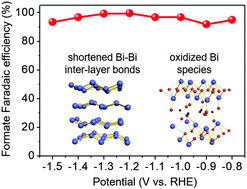Bismuth oxyiodide microflower-derived catalysts for efficient CO2 electroreduction in a wide negative potential region†
Abstract
It is of paramount importance to design and develop highly active and selective electrocatalysts for the CO2 reduction reaction. Herein, we obtained bismuth-based catalysts consisting of oxidized Bi2O2CO3 and metallic Bi featuring local shortened inter-layer Bi–Bi bonds from in situ reduction of bismuth oxyiodide (BiOI) microflowers, which showed over 90% formate faradaic efficiency in a wide negative potential region.



 Please wait while we load your content...
Please wait while we load your content...